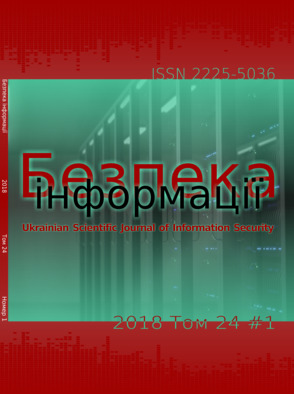Theoretical foundations for the method of separating the clone from the prototype in a digital image
DOI:
https://doi.org/10.18372/2225-5036.24.12341Keywords:
digital image, integrity violation, cloning, clone, prototype, separation of the clone from the prototype, block, distinctive outskirtAbstract
If digital images, digital video are used for an unattractive purpose, then unauthorized violations of their integrity can lead to negative consequences for an individual, for society as a whole. Therefore, the task of detecting the violation of the integrity of information content, in particular, digital images, which are considered in the work, is extremely relevant. Cloning is most often used for unauthorized changes of digital images. Cloning is the process by which a part of the image (prototype) is copied and transferred to its other area. So the clone is formed. The problem of separating the clone from the prototype is the most difficult. If the clone and the prototype are processed equally or not processed at all, then this problem does not have a satisfactory solution at this moment. The solution of such a problem will make it possible to increase the informative value of the results of cloning detection. The existing methods for solving this problem use, as a rule, the technology of digital watermarks. The introduction of a digital watermark into an image allows you to monitor the process of its subsequent unauthorized changes, but it breaks the integrity of the image. The aim of the work is to develop the theoretical foundations for the method of separating the clone from the prototype. This method should not use digital watermark technology. It must be effective under conditions where the clone and the prototype are treated identically. Theoretical bases use a block-oriented approach. A quantitative parameter is found in the work, which makes it possible to effectively separate the clone region from the prototype. This parameter is the norm of the distinctive neighborhood of the clone/prototype. A distinctive neighborhood is a square matrix of small size. Elements of this matrix reflect the difference of the clone/prototype block from the neighboring blocks in the image. The maximum efficiency of separating the clone from the prototype is achieved when the radius of the distinctive neighborhood is 1. The results of the computational experiment are presented.The errors do not exceed 5,5% for a 32*32 pixel block in conditions of saving a cloned image in lossless format (Tif), as well as with losses (Jpeg) with different quality factors. The errors do not exceed 7,5% in conditions of complex disturbances.References
D. Cozzolino, «Efficient dense-field copy-move forgery detection», IEEE Transaction on Information Forensics and Security , Vol. 10, No. 11, рp. 1–14, 2015.
Manish Deoli, Jyoti Joshi, «A Fast and Robust Approach to Detect Copy-Move Forgery in Digital Images», International Journal of Computer Applications Volume, Vol. 137, No. 5, рp. 29–33, 2016.
N. Anantharaj, «Tampering and Copy-Move Forgery Detection Using Sift Feature», International Journal of Innovative Research in Computer and Communication Engineering, Vol.2, Iss. 1, рp. 2132–2137, 2014.
C. Prerna, J. Рercy Granaph, S. Angaline., I.Thanga Belsi, «A keypoint based copy-move forgery detection», International Journal of Advanced Information Science and Technology, Vol. 12, No. 12, рр. 234-245, 2013.
А.А. Кобозева, И.И. Бобок, Л.М. Дзюбинская, «Выявление нарушений целостности цифрового изображения путем использования стеганографических алгоритмов», Інформатика та математичні методи в моделюванні, Т.5, №2, с. 129-134, 2015.
Е.Ю. Лебедева, «Метод локализации и идентификации оригинальной и клонированной областей изображения», Інформатика та математичні методи в моделюванні, Том 4, №1, с. 76 – 84, 2014.
І.І. Бобок, «Метод відокремлення клону від прообразу в цифровому зображенні в умовах відсутності відмінностей при їх постобробці», Інформатика та математичні методи в моделюванні, Т.7, №4, с. 298-307, 2017.
C.М. Григоренко, «Розвиток методу виявлення клонування в цифровому зображенні в умовах додаткових збурних дій», Правове, нормативне та метрологічне забезпечення системи захисту інформації в Україні, Вип. 1(31), с. 85–98, 2016.
Р. Гонсалес, Р. Вудс, Цифровая обработка изображений, М.: Техносфера, 1070 с., 2006.
NRCS Photo Gallery, United States Department of Agriculture. Washington, USA. URL: http:/pho togallery.nrcs.usda.gov.

